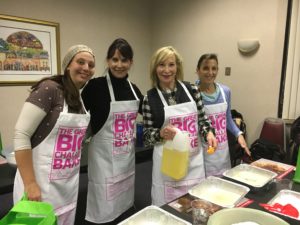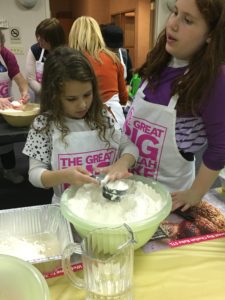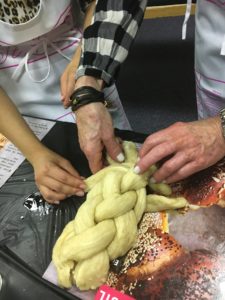The Mitzvah of Women Making Challah
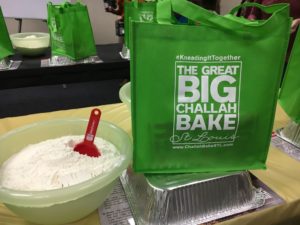 Whenever I make challah with my girlfriends, and we’re schmoozing, mixing, kneading, and laughing, the braided breads always turn out better than when I shape the dough by myself in my kitchen. And I’m not sure why, maybe it’s my imagination. We use the same ingredients—yeast, water, sugar, flour, oil, egg, salt—a basic bread recipe, although some women go gourmet and add sweet or savory fillings and create fancy designs. It must be the energy in the room, the shared focus on why we are here, that makes challah taste better when we make it together. The rhythm of squishing the sticky dough through our fingers and leaning in to it with our hands can work up a sweat if we’re doing it right. And when the floury soft mound finally forms, I can’t resist patting it like a baby’s bottom. By the time we catch the first whiff of fragrant yeast, we are transcended to a different space. When we make challah together, we forget about our list of things to do and just be in the moment.
Whenever I make challah with my girlfriends, and we’re schmoozing, mixing, kneading, and laughing, the braided breads always turn out better than when I shape the dough by myself in my kitchen. And I’m not sure why, maybe it’s my imagination. We use the same ingredients—yeast, water, sugar, flour, oil, egg, salt—a basic bread recipe, although some women go gourmet and add sweet or savory fillings and create fancy designs. It must be the energy in the room, the shared focus on why we are here, that makes challah taste better when we make it together. The rhythm of squishing the sticky dough through our fingers and leaning in to it with our hands can work up a sweat if we’re doing it right. And when the floury soft mound finally forms, I can’t resist patting it like a baby’s bottom. By the time we catch the first whiff of fragrant yeast, we are transcended to a different space. When we make challah together, we forget about our list of things to do and just be in the moment.
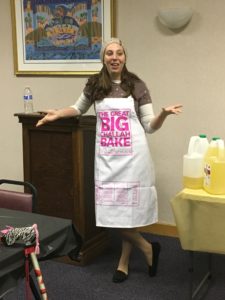 On October 25 2018, more than one million Jews around the world came together for that purpose, to make challah and reconnect through the magic of Shabbat as part of The Shabbat Project. This grassroots global initiative unites Jewish people from all nationalities and backgrounds and transcends the barriers that divide us. It’s our opportunity to renew family and community life, restore Jewish identity, and unite Jews across the globe. It’s about creating a new Jewish future together. And it starts with us, with me, and a bag of flour.
On October 25 2018, more than one million Jews around the world came together for that purpose, to make challah and reconnect through the magic of Shabbat as part of The Shabbat Project. This grassroots global initiative unites Jewish people from all nationalities and backgrounds and transcends the barriers that divide us. It’s our opportunity to renew family and community life, restore Jewish identity, and unite Jews across the globe. It’s about creating a new Jewish future together. And it starts with us, with me, and a bag of flour.
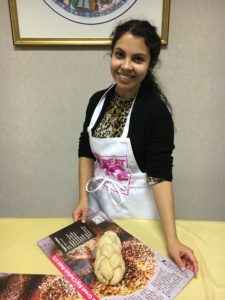
Throughout the ages, women are considered the heart and soul of Judaism and with that becomes great responsibility. Our home and sanctuary are meant to be one in the same, and with that expectation certain mitzvot are set aside especially for women. Family purity laws, candle lighting on Shabbat and holidays, and the separation of challah are rituals that women proudly observe and steadfastly pass down to the next generation.
So, why is challah not like any other bread? Actually, the word “challah” doesn’t even mean bread or dough. The root of the word is chol which means ordinary, mundane, or secular. Taking something ordinary, like bread that sustains life, and elevating it into a divine dough that nourishes the soul, is in the hands of women.
Making challah for Shabbat bonds two worlds –spiritual and physical—in which we all live. Challah is a mitzvah in the Torah which enjoins us to set aside one piece of dough from each batch we make, as it says: “…It shall be that when you eat the bread of the land, you shall set aside a portion [of dough] for God.”
The Torah reminds us that everything in its essence is holy, kodesh, and always will be. God gives us permission to use His world for a “mundane, chol” purpose, under one condition: that we keep it holy.
This is especially true in regard to challah. Nothing is more “ordinary” than eating, and bread and water sustain us. At our Great Challah Bake at Aish last night, as part of The Shabbat Project, we learned that challah is like a mini-universe.
Just as the globe is land and water, the human is composed of earth — compared to flour, and spirit and intellect — compared to water. Humans, as a combination of body and soul, flour and water, are like a dough. By separating challah we consecrate our multifaceted identity, the “dough.” Many women take advantage of this moment to pray for their families, for our people, and for the restoration of the Temple, or for anyone who is in need of special merit. We use this egg-size piece of dough to ask God for any blessing we want, for new beginnings or changes in our life. It’s a special time to spiritually connect with God that expands way beyond our kitchen walls. Saying this prayer is the moment that a mundane task of making bread rises to something holier, and this mitzvah is  given to women, specifically.
The blessing is: Baruch ata Adonoy, Eloheinu melech ha-olam, asher kidishanu bimitzvo’sav, vitzivanu lihafrish challah min ha-issa.
 Blessed are You God, King of the Universe, Who made us holy with His commandments, and commanded us to separate challah from the dough.
Because everything has meaning and a special custom that goes along with it, we have specific instructions to discard this challah after we pray. Â In times of the Holy Temple, this piece of dough or challah would be consecrated for use by the kohanim (priests) and their families. Today, although the Temple no longer exists tangibly, it is still the focus of our spiritual vision of our identity as a people. To commemorate it, we take the piece of dough and either discard it (after wrapping it so that it doesn’t come in direct contact with the rest of the trash) or burn it. If you burn it, it should be wrapped in aluminum foil, and nothing else should be baking in the oven at the same time.
So the next time you bite into the chewey, fresh piece of aromatic braided bread that we have come to call challah, know that it is made with love and intent to nourish the body, mind, and soul.
Shabbat Shalom!
